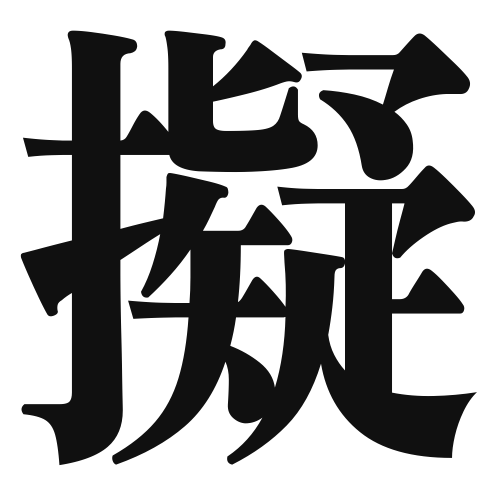1. Overview of Meaning
The kanji “擬” (gi) means “to imitate,” “to pretend,” or “to simulate.” It conveys the idea of mimicking something or someone, often in a way that is not genuine or real.
2. Formation and Radical
Formation of the Kanji: The kanji “擬” is a compound character (会意文字) that combines elements to convey its meaning. It consists of the radical “手” (meaning “hand”) and the phonetic component “ギ” (gi), which contributes to its pronunciation.
Radical: The radical of “擬” is “手” (shǒu), which is commonly associated with actions related to the hand, emphasizing the act of doing or performing.
3. Examples of Usage
Common Words and Phrases: Some frequently used words that include “擬” are:
- 擬似 (ぎじ, giji) – “simulated” or “pseudo”
- 擬人化 (ぎじんか, gijinka) – “personification”
Example Sentences in Daily Conversation:
- 彼はそのキャラクターを擬似的に演じている。
(Kare wa sono kyarakutā o giji-teki ni enji te iru.)
“He is imitating that character in a simulated way.” - この映画は擬人化された動物が出てくる。
(Kono eiga wa gijinka sareta dōbutsu ga dete kuru.)
“This movie features animals that are personified.”
4. Synonyms and Antonyms
Similar Kanji: A kanji with a similar meaning is “模” (mo), which means “to model” or “to pattern.” While both “擬” and “模” involve imitation, “模” often refers to creating a model or representation, whereas “擬” implies a more deceptive imitation.
Opposite Kanji: An antonym for “擬” is “真” (shin), which means “true” or “genuine.” This contrasts with “擬,” as it represents authenticity rather than imitation.
5. Cultural and Historical Background
Relation to Japanese Culture: The concept of imitation is significant in Japanese culture, particularly in art and performance, where traditional forms often involve mimicking nature or historical figures.
Proverbs and Idioms: One relevant proverb is “猿真似” (saru mane), which means “monkey see, monkey do,” highlighting the idea of imitation in a more playful context.
